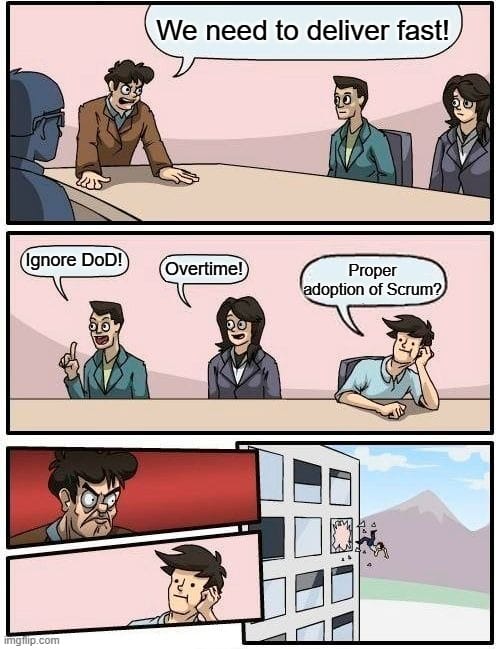Scrum: The Framework We Use, Ignore, and Misunderstand
A lot of companies claim to use it, but in reality, it’s often just a buzzword.

In December 2024, I earned my Professional Scrum Master I (PSM I) certification. It felt great to check that off my list, but more than that, it gave me a chance to reflect on my journey with Scrum and Agile over the past decade. It’s been a wild ride—one filled with lessons, frustrations, and a growing appreciation for what Scrum is really about.
Scrum vs. Reality
For more than 10 years, I’ve worked in companies that proudly declared, "We’re an Agile company!" or "We use Scrum!" But let’s be honest: most of them didn’t really know what Scrum was. Sure, they might hold daily stand-ups and throw around words like "sprint" and "backlog," but beyond that? Not much.
In startups especially, Agile often becomes a convenient excuse for moving fast. Investors demand speed-to-market as a key metric, so anything that seems like it might slow things down gets tossed aside. Retrospectives? Nah, who’s got time for that? Definition of Done? Let’s redefine it so we can ship something—anything—this week.
Looking back, most of what we did wasn’t Scrum at all. It was more like a mix of guesswork, firefighting, and a daily stand-up to feel productive.
Where Scrum Falls Apart
Over the years, I’ve noticed some common patterns in companies that claimed to follow Scrum. Here are a few:
- Scrum Values? What Values? Scrum is built on five core values: commitment, courage, focus, openness, and respect. These are supposed to guide how teams work together, but in practice, they’re often ignored. Without these values, Scrum is just a buzzword.
- Setbacks = Blame Games Scrum treats setbacks as opportunities to learn and improve. But in many companies, setbacks lead to fault-finding. At best, they’re handled with quick fixes and firefighting, without any real retrospection. In some places, retrospectives are seen as a waste of time—a luxury teams can’t afford.
- Definition of Done? Let’s Wing It Scrum emphasizes delivering a usable, working increment defined by a clear Definition of Done (DoD). Yet, I’ve seen executives override this to push features out the door prematurely. Why? Because someone, somewhere, made a promise to a client or investor. The result? Half-baked features, frustrated users, and demoralized teams.
- The Business vs. Tech Tug-of-War Ideally, business and tech should collaborate daily. But the reality is that everyone is too busy chasing their own KPIs. When things go wrong, it often leads to finger-pointing. Business teams accuse tech of being too slow; tech teams accuse business of unclear requirements and shifting priorities. Over time, trust erodes, and it becomes harder to work together.
- Short-Term Thinking In startups, cash flow often takes precedence over everything else—even the user. Decisions are made to meet immediate financial goals, often at the expense of long-term product quality and user satisfaction. Once investor money comes into play, the user is no longer the top priority.
Why I Still Believe in Scrum
Despite all this, I’m still a big advocate for Scrum. Why? Because at its core, Scrum is about people—building trust, fostering collaboration, and solving complex problems together. It’s not just a framework; it’s a mindset.
What Makes Scrum Special
Here are the principles and values that stand out to me:
The Agile Mindset
- Individuals and interactions over processes and tools
- Working software over comprehensive documentation
- Customer collaboration over contract negotiation
- Responding to change over following a plan
The Agile Values
- Delivering value early and continuously.
- Welcoming change, even late in development.
- Frequent delivery of working software.
- Daily collaboration between business and tech teams.
- Motivated individuals with trust and support.
- Face-to-face communication.
- Working software as the primary measure of progress.
- Sustainable development pace.
- Technical excellence and good design.
- Simplicity.
- Self-organizing teams.
- Regular reflection and improvement.
The 3 Pillars of Scrum
- Transparency
- Inspection
- Adaptation
The 5 Scrum Values
- Commitment
- Courage
- Focus
- Openness
- Respect
If teams truly embrace these values, they’re unstoppable. They’re the kind of teams where people love to work and where quality delivery becomes second nature.
Looking Ahead
Am I overly optimistic about fully adopting Scrum in Southeast Asia, where organizations are often investor-driven? Maybe. But now that I’ve taken the time to learn Scrum deeply and earn my certification, I feel better equipped to help steer teams in the right direction.
I know that businesses will always be revenue-driven. The key to convincing them of Scrum’s value lies in delivering real, tangible benefits. That’s something I’m still learning to do, but I’m excited to figure it out.
For now, I’m just glad to have taken this step. Scrum isn’t perfect, but its principles and values are worth striving for. And who knows? Maybe one day, I’ll get to be part of a team that fully embraces them. If that happens, I’ll know I’ve found something truly special.
